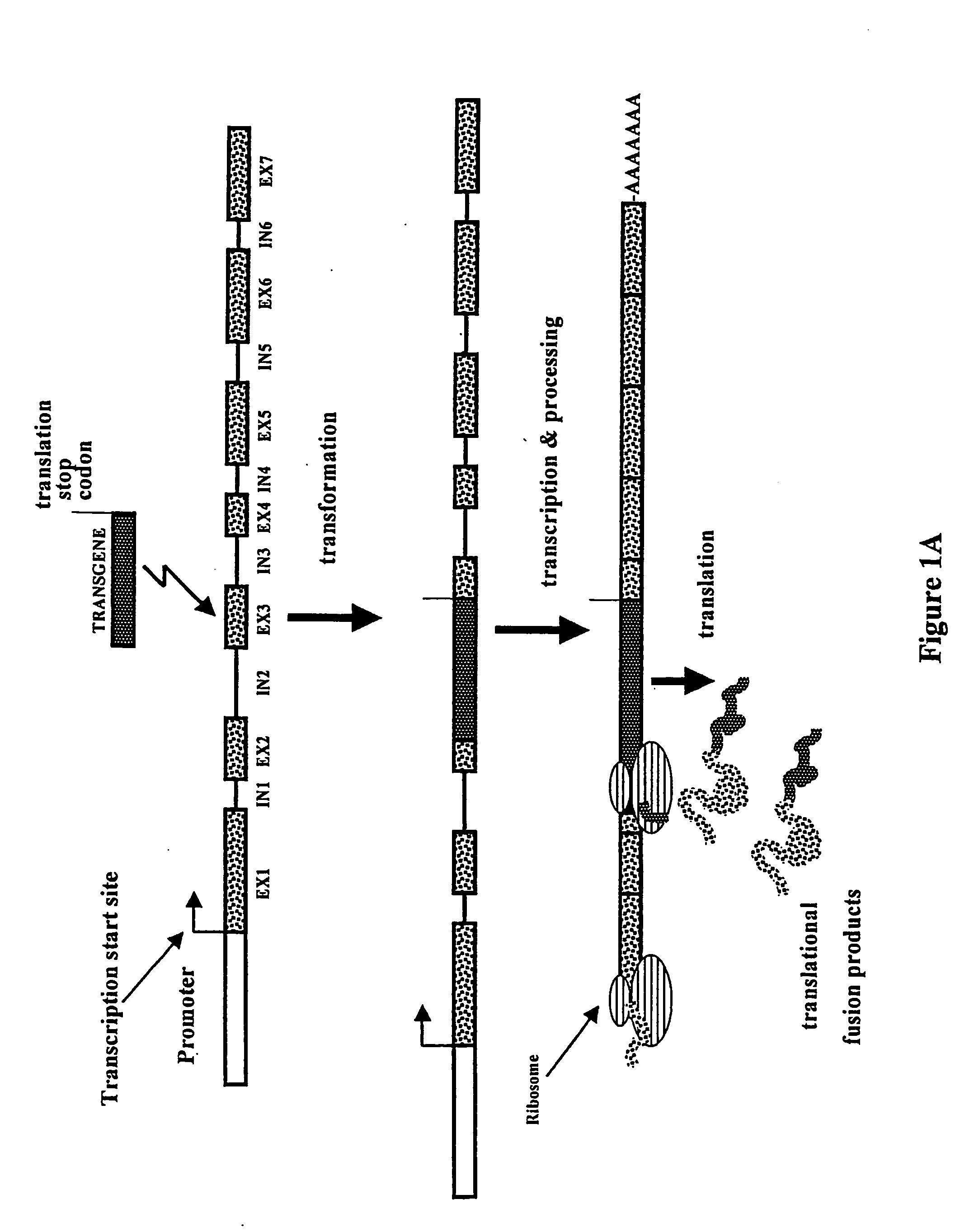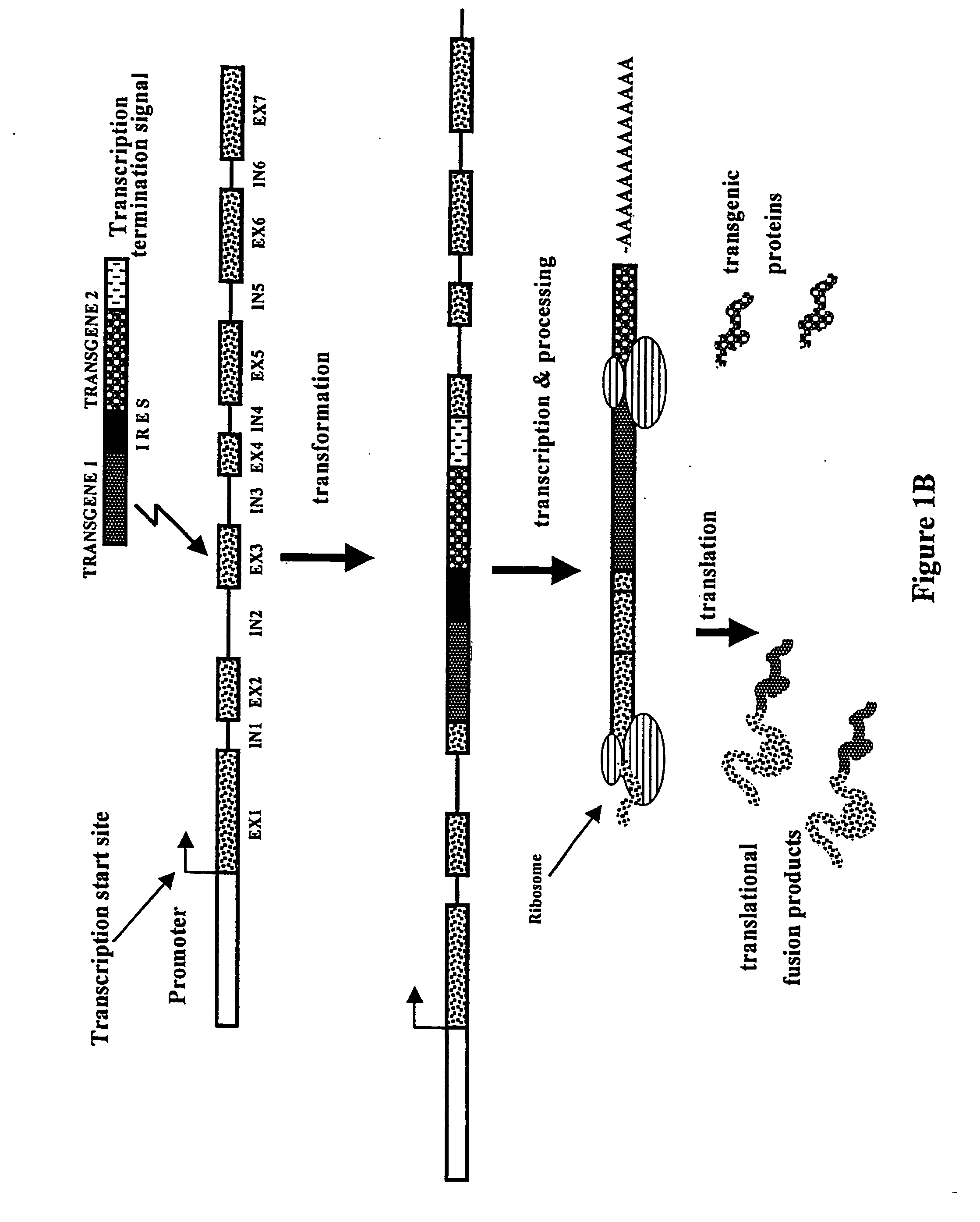Processes and vectors for producing transgenic plants
- Summary
- Abstract
- Description
- Claims
- Application Information
AI Technical Summary
Benefits of technology
Problems solved by technology
Method used
Image
Examples
example 1
[0054] Construction of IRES-Containing and Translational Fusion Vectors
[0055] Series of IRES-mediated expression vectors were constructed using standard molecular biology techniques (Maniatis et al., 1982, Molecular cloning: a Laboratory Manual. Cold Spring Harbor Laboratory, New York). Vector pIC1301 (FIG. 2) was made by digesting plasmid pIC501 (p35S-GFP-IRES.sub.MP,75.sup.CR-BAR-35S terminator in pUC120) with HindIII and religating large gel-purified fragment. The IRES.sub.MP,75.sup.CR sequence represents the 3' terminal 75 bases of the 5'-nontranslated leader sequence of the subgenomic RNA of the movement protein (MP) of a crucifer (CR)-infecting tobamovirus.
[0056] A construct containing a promoterless BAR gene was made by deleting the 35S promoter from a plasmid containing p35S:BAR-3'35S (pIC1311, not shown). Plasmid pIC1311 was digested with HindIII-NruI and blunt-ended by treatment with Klenow fragment of DNA polymerase 1. The large restriction fragment was gel-purified and r...
example 2
[0059] PEG-Mediated Orotoplast Transformation of Brassica napus
[0060] Isolation of Protoplasts
[0061] The isolation of Brassica protoplasts was based on previously described protocols (Glimelius K., 1984, Physiol.Plant., 61, 3844; Sundberg & Glimelius, 1986, Plant Science, 43, 155-162 and Sundberg et al., 1987, Theor. Appl. Genet., 75, 96-104).
[0062] Sterilized seeds (see Appendix) were germinated in 90 mm Petri dishes containing {fraction (1 / 2 )} MS medium with 0.3% Gelrite. The seeds were placed in rows slightly separated from each other. The Petri dishes were sealed, tilted at an angle of 45.degree. and kept in the dark for 6 days at 28.degree. C. The hypocotyls were cut into 1-3 mm long peaces with a sharp razor blade. The blades were often replaced to avoid the maceration of the material. The peaces of hypocotyls were placed into the TVL solution (see Appendix) to plasmolise the cells. The material was treated for 1-3 hours at room temperature. This pre-treatment significantly i...
example 3
[0068] Transformation of Triticum monococcum by Microprojectile Bombardment
[0069] Plant Cell Culture
[0070] Suspension cell line of T. monococcum L. was grown in MS2 (MS salts (Murashige & Skoog, 1962 Physiol. Plant., 15, 473-497), 0.5 mg / L Thiamine HCl, 100 mg / L inosit, 30 g / L sucrose, 200 mg / L Bacto-Tryptone, 2 mg / L 2,4-D) medium in 250 ml flasks on a gyrotary shaker at 160 rpm at 25.degree. C. and was subcultured weekly. Four days after a subculture, the cells were spread onto sterile 50 mm filter paper disks on a gelrite-solidified (4 g / L) MS2 with 0.5 M sucrose.
[0071] Microprojectile Bombardment
[0072] Microprojectile bombardment was performed utilizing the Biolistic PDS-1000 / He Particle Delivery System (Bio-Rad). The cells were bombarded at 900-1100 psi, at 15 mm distance from a macrocarrier launch point to the stopping screen and 60 mm distance from the stopping screen to a target tissue. The distance between the rupture disk and the launch point of the macrocarrier was 12 mm. ...
PUM
| Property | Measurement | Unit |
|---|---|---|
| Recombination enthalpy | aaaaa | aaaaa |
Abstract
Description
Claims
Application Information
 Login to View More
Login to View More - R&D
- Intellectual Property
- Life Sciences
- Materials
- Tech Scout
- Unparalleled Data Quality
- Higher Quality Content
- 60% Fewer Hallucinations
Browse by: Latest US Patents, China's latest patents, Technical Efficacy Thesaurus, Application Domain, Technology Topic, Popular Technical Reports.
© 2025 PatSnap. All rights reserved.Legal|Privacy policy|Modern Slavery Act Transparency Statement|Sitemap|About US| Contact US: help@patsnap.com



